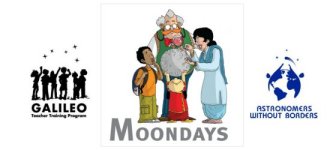
The Galileo Teacher Training Programme MoonDays is being launched in support to theAstronomers Without Borders global event: Global Astronomy Month 2011. The Educator’s Corner is just one of the components of the GTTP MoonDays. Since the list of ideas and projects produced to support the venue can be used all year long we decided to publish several of these as resource in our website. You will find bellow suggestions to participate in GAM2011 and gain prizes or simple nice ideas to support your projects along the year.
The goal of this section is to provide inspiration to engage students in the study of several different aspects of the Moon, using whichever means they have available to reach this purpose: naked eye observations, small telescopes, binoculars, astrophotography, robotic telescopes, webcams, image databases, imagination, creativity, etc. and submit a report, present a project, an essay, an art work.etc
Submit your project to GAM2011 contest and win prizes! Each participant will receive a Certificate and as we will put up a gallery on our website, all entries will get global recognition!
Who can enter?
Everyone. There are 4 differente age groups as defined bellow.
What to do?
There are 2 types of contests: Projects and Art Work .Participants a free to choose the one they want their work to enter on . All projects and art works must be in English.
Where to upload the project and what type of files?
Material should be sent to: info@galileoteachers.org
Criteria that will be used in the rating system:
– Creativity and Inovation
– Scientifically Correct
– Content Richness
What are the age groups?
Group 1 – 7 to 12
Group 2 – 13 – 15
Group 3 – 16 to 18
Group 4 – > 18
Prizes that can be won:
– All participants will get a certificate
– The best project in each category will receive a binocular
The deadline of entering into the competition is May 31st/2011
The selection of the best 3 per category will be made by the public and the voting will be open until July 15th. A juri will select the best 20 per category and those will be made available for public voting after June 15th. Announcement of winners and prizes distribution will take place in July.
Participants are free to come up with their own ideas but if your creativity is low, here is a list of suggestions to trigger your imagination. Just follow the links or scroll down the page to check out all the suggestions.
Size of the Moon and the eclipses
The Moon’s importance for life on Earth
Moon exploration in our daily lives
The Moon looks like a big cheese?
(Observing by naked eye, using small telescopes, robotic telescopes, webcams or simply using images database)
Suggestion of resources:
¬ A selection of activities using the user friendly image processing software Salsa J: http://www.handsonuniverse.org/ms/HOSS-TG2006.pdf
¬ Explore the Moon with the help of astronauts using Google Moon: http://earth.google.com/moon/
¬ Skywatchers guide to the Moon: http://nightsky.jpl.nasa.gov/download-showdoc.cfm/ObserveMoon.pdf?Doc_ID=331&Doc_Filename=ObserveMoon%2Epdf&InfoLogged=1&Anon=0
¬ Guide on observing the Moon: http://stardate.org/pdfs/teachers/ObservingTheMoon.pdf
¬ You are Galileo: http://www-irc.mtk.nao.ac.jp/~webadm/Galileo-E/index.php?Field%20note (scroll down to the section about the Moon)
¬ UNAWE: What does the full moon look like http://unawe.org/joomla/index.php?option=com_content&task=view&id=256&Itemid=136
Suggested Projects: Write an essay/produce a presentation on the importance of space explorations, make a drawing or a picture of the Moon as you observed it and identify features on the Moon, identify the Apollo Landing spots, measure Moon Craters and find one with the same size of your city; propose an exploration mission. Sketch of the Moon done by hand; Moon pictures; etc
2) Faces and phases of the Moon
Suggested Resources:
Why does the Moon have phases?
Does the Moon Rotate around itself ?
Virtual observatories:
Suggested Projects: Write a tale explaining the phases and faces of the moon. Write an essay/produce a presentation on what we know about the far side of the Moon. Build a model to help explain the phases of the moon and the synchronous rotation. Build an activity using Stellarium or Celestia to explain the different views of the Moon in different parts of the world.
3) Size of the Moon and the eclipses
Suggested Resources:
Virtual observatories:
Suggested Projects: Write a tale explaining why eclipses happen. Write an essay/produce a presentation rebuilding the history of men perception of what eclipses are. Build a selection of digital images using Celestia or Stellarium reproducing a solar and a lunar eclipse from different points of observation on Earth, Moon and Sun.
4) The Moon’s importance for life on Earth
Suggested Resources:
Information about different hypothesis on how was the Moon formed
Suggested Projects: Write an essay/produce a presentation spotting the relevant aspects of our natural satellite that makes it so important to life on earth. Write an essay/produce a presentation exploring the possibilities of life existing elsewhere in the Solar System.
5) Moon exploration in our daily lives
Suggestion of resources:
Suggested Projects: Produce a video in your school selecting everything whose development started in space exploration. Write an essay/produce a presentation on the impact of Astronomy and Space Exploration in our daily lives.
6) A sense of scale
Suggestion of resources:
Why can’t I see the American Flag on the Moon ?
Find a crater the size of your town using the Hands-on Universe Solar System Book
7) Moon Research
Write an essay with the help of a researcher about current topics on Moon research
Make a review on current and future lunar missions, their mission objectives, their targets, etc
You can review some of the suggested links in the GTTP MoonDays New Tech
8) The Moon looks like a big cheese?
Capture the beauty of the Moon with a guided lesson
